WASHINGTON, DC
June 30, 2014
STRANGER: Brendan Kelleher
LOCATION: Pizzeria Paradiso, 2003 P Street NW, Washington, DC
THEME: Dining with a beer brewing enthusiast
Brendan Kelleher loves to talk about brewing beer.
He’ll strike up a conversation with anyone about it, and his love for the beverage is what led him to launch Behind The Craft, a website where he interviews owners of craft breweries and learns about the process of making specialty beers.
It’s drinking with strangers.
For his website, Brendan records podcast interviews with brewers. But he had emailed me saying it’d be nice to be on the other end of the microphone for once. So we met at Pizzeria Paradiso in the Dupont Circle neighborhood of Washington, DC, for pizza and beers. Among the various pizza places in town, this one has an extensive beer menu, making it perfect for the interview.
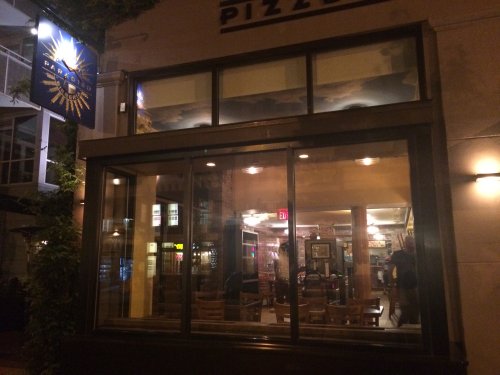
I’d arrived a few minutes early so had a chance to belly up to the bar and look around the place. It’s a well-lit restaurant, wooden tables and chairs dotted around the space. The walls are decorated with a seemingly random collection of plates, paintings and other artwork. The kitchen forms the back of the restaurant, with the chefs visible to the diners — and there were many of them.
Dupont is a popular neighborhood for tourists, and the restaurant is steps from a subway station. So Pizzeria Paradiso was packed even when I arrived at 9pm on a Monday.
Nevertheless, when Brendan walked in, we were seated quickly.
As we browsed the menus, he told me that we should get some beers so he could talk me through them. I’m a layman at best when it comes to distinguishing different types of beers, but Brendan assured me that he’d be able to help me learn a bit more about them.
He did so in a friendly manner, speaking in everyday language free of pretension. The first beer we ordered was a Resurrection by Brewer’s Art in Baltimore.
After a few sips, all I could tell Brendan was a simple-minded statement that it was “nice” to drink. But he didn’t patronize my lack of knowledge. Instead, he walked me through a description of the beer that made me learn more about what I was tasting in a way I could understand. He talked about how the beer creates a pleasant yet dry sensation at the front of the mouth, leaving the drinker with a slightly bitter taste of tannins. Armed with this explanation, I tried a few more sips and, sure enough, was able to distinguish the sensations he told me.
The plain language is the same that Brendan, 36, uses for his podcasts. “The idea of the show is the same as if I sat down next to you at a bar and we started talking about beer, it’s no different,” he said.
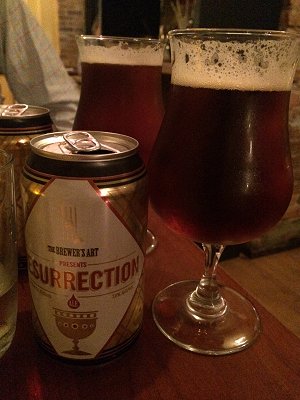
“I am every man,” he said. “There’s nothing inherently different about me other than my walk of life. I refrain from trying to be the guy who thinks he knows it all. I really don’t.”
He’s always enjoyed trying new beer, particularly when paired with great food. Brendan now lives in the area with his wife and children, but several years ago their home was Chicago. That’s where Brendan had a men’s dinner group, getting together once a month to sample a chef-devised menu with novel foodstuffs and alcohol pairings. And the love of food continues to this day, as part of the Behind The Craft website includes a “kitchen” section with recipes dreamed up by his friend, chef Mykl Wu.
“I always wanted to do a podcast,” he said, because he likes learning new things from the many people he interacts with. But in talking about the idea with friends, they suggested that interviewing everyone possible might get a little unwieldy. So he targeted brewers.
“Beer can bring people together. But you never really think about the guy that made it. Who is it that’s making this stuff that we drink? Everybody has a story, and I thought it would be cool to hear the story of the people who are out there making this amazing stuff,” he said.
To get started, he called up a few craft brewers and started doing interviews with them. He’d drive out to breweries in the area or nearby states, and enjoy a few samples of the products while conducting interviews with the owners or other staff.
He picked a good location for it. In recent years, Washington has seen a mini-explosion of craft breweries and other smaller-scale alcohol producers. To name just a few (including some breweries that Behind The Craft has featured in its recent interview podcasts) there is Chocolate City Beer, DC Brau, Port City, and Right Proper. And the industry’s growth doesn’t show signs of stopping.
With all these dinner interviews, my waistline growth also shows no signs of stopping. The food at Pizzeria Paradiso did nothing to halt that pace.

After a short wait, our pizzas arrived and I immediately regretted going for the twelve inch dish over the nine inch. I chose the Quattro Formagi with gorgonzola, pecorino, fontina, mozzarella, minced garlic and parsely. This thing was massive.
And it as delicious. The cheese was spread around in just the right amount. And despite the blend of various cheeses, this wasn’t a greasy pizza. Slices didn’t drip oil when I picked them up. The minced garlic lingered with every bite.
Even though I had more than enough pizza to get through, Brendan kindly offered me a slice of his self-devised creation. Vowing a gym visit the next day, I happily obliged.
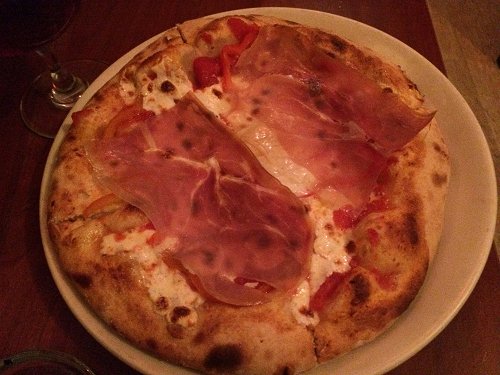
He chose a Miniera pizza, which starts with a base of a smooth tomato sauce and mozzarella, allowing diners to pick three toppings. Brendan chose prosciutto, red peppers and a fried egg. Our waitress told us at the time of ordering the egg would come out sunny side up.
It was an interesting mix of ingredients. The peppers were in thick slices, giving each bite a nice crunch and kick. And once the egg was split, the yolk ran among the pizza and gave a different but tasty coating to the cheese and meat. Thumbs up for both our dishes.
I have nothing negative to say about the food at Pizzeria Paradiso, and Brendan likewise said that his motto for Behind The Craft is either good press or no press. “If I don’t like something, well, we all have different opinions, and I don’t need to sit there and tell you why I don’t like something. It could possibly influence your own decision and I don’t see the point in that,” he said.
“Sometimes I get ridiculed by friends or by emails from people who say I just should say I don’t like a particular beer. But if I can find a redeeming quality of something, I will, so why not focus on that? Especially if it’s the only beer that you can drink at the moment,” Brendan said.
He focuses on the positives visiting the various breweries, describing his trips in plain language that makes it easier for him to get across his thoughts. You won’t find him going on literary flights of fancy comparing the taste of a smoky beer to something like the dying embers of a campfire under a moonlit sky in the heart of the Shenandoah, for example.
“I just say what I’m feeling,” Brendan said. “I might say a beer is sweet. So someone could say, ‘What kind of sweet’? I don’t know. It’s just sweet.”
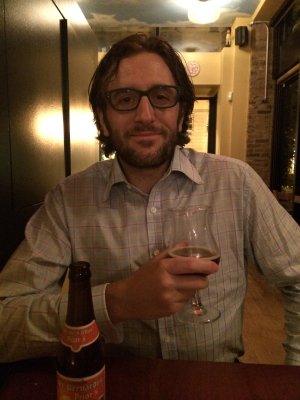
The only times he might make comparisons is when they ring true. For example, he remembers trying a beer that gave off a strong smell of caramel. That was enough to trigger memories of when his wife makes caramel at home — and the mention of his spouse made him smile again.
He noted how his wife finds it curious whenever Brendan ends up taking 60 photos of one beer, but it’s all in the name of presenting great images for his website.
The future Kellehers met in Chicago, where they lived until two years ago. Brendan was working as a trader for futures markets, a job he never planned to do.
Chicago is technically his hometown, although as a self-described “Air Force brat” — his father was a pilot in the military — the family moved around a lot, including stints in South Dakota, Germany, Texas and Arkansas. The last state is where his father died in a plane crash, after which Brendan, his mother and two brothers lived in several other locations.
The family eventually settled In Mississippi, where Brendan went to the University of Southern Mississippi in Hattiesburg. “I highly suggest you never go to Mississippi,” he said with a grin. “There is nothing to do there.” So he threw himself into his college life and was part of the cross-country track team. But then he hurt his knee, couldn’t do track anymore, and from there he lost interest in university. Eventually he dropped out, and found himself aimless in the Magnolia State.
That’s when a friend who lived near Chicago suggested that Brendan come visit. One day later, he got in his car and drove north. His move to the Windy City was complete.
He was only 19 at the time, and started doing various odd jobs, including working to help organize trade shows, a gig that allowed him to travel the country and stay at luxury hotels.
Eventually he wound up working at a bar, and some of his regulars were from the Chicago Board of Trade. They would often talk about their work in the fast-paced world of finance and futures trades, and it intrigued Brendan. But he still had his work at the bar.
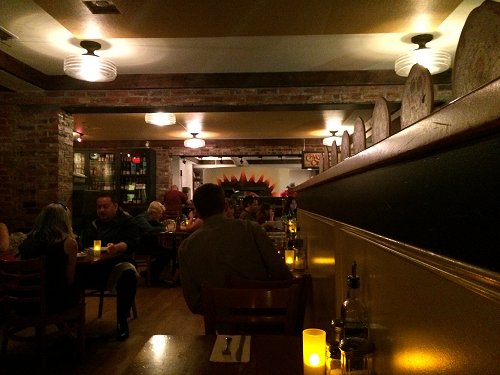
Things were however about to change. He was let go from the bar, and in need of work he decided to call up every company registered with the Board of Trade. Eventually one of them offered him an interview. “I thought this was great, so I put on my best suit and went down there,” Brendan said. “And then the interviewer was asking me all these weird questions, like how much can I carry and how far can I walk.” He must have said the right things, as they offered him a job.
Once he started, the questions made sense. He was essentially an errand boy, working at the bottom of the ladder in the company. Yet the role gave him valuable access.
“I worked so hard for those guys, and I kept bugging them about being a trader’s assistant,” Brendan said. Finally the bosses granted him his wish, setting him up as a clerk to a trader who had a reputation for a strong work ethic but a mean attitude. The guy was fond of screaming on the trading floor, according to Brendan. “I’m somewhat deaf in my left ear because he was on that side of me and would yell through me,” he said. I wasn’t sure if he was joking.
Brendan loved the frenetic environment of the trading floor, telling me that the Dan Akyroyd and Eddie Murphy movie “Trading Places” — which features scenes of people shouting and papers flying on second-by-second million-dollar trades — is as close as Hollywood has gotten to accurately showing was his life was like. The advent of electronic trading was coming however, and Brendan’s boss showed a reluctance to get up to speed on computer-based trading.
As a result of falling behind the times, his boss ran out of money to trade and Brendan was fired. He took on a temporary job selling shoes at a shop on Michigan Avenue (home to high-end clothing stores). That didn’t last long, as he soon ran into a trader he knew, who offered him a position at his company on a temporary two-week, unpaid basis. The trader said that if Brendan made him enough money in two weeks, he would be able to get a permanent position.
“After one week he offered me a job,” Brendan said.
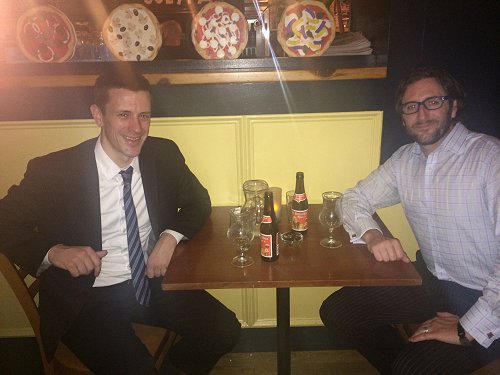
He worked with that company for a while, and then another. It was a job with strange hours. He covered Asian and European markets, so worked 6pm to 6am. That life meant that most of his close friends were traders because they kept the same hours.
His wife’s desire to leave the Chicago school system shook things up, as the couple decided to move out east to be close to her family in the DC area. For a while, Brendan continued to trade from home via his computer. But eventually some bad trades and an inability to make big bucks made him think it was time to get out of the industry.
“I don’t want to say the market changed and that’s why I couldn’t make money anymore. I take responsibility,” Brendan said. “One day I just told my wife I was done. It was so hard because I really loved trading. I loved that every day was different.”
He now works as a haberdasher, able to use experience from he worked at department stores in Chicago. But he still has fond memories of his time as a trader.
He added, “One of my favorite things was to be the first person in the world at that time period that traded a particular price. Something about that was so cool, feeling like I was connected with people around the world. But I romanticize the shit out of everything.”
Laughing at that last remark, he told me that he also romanticizes his love of beer. And he was happy to take a break from his life story to tell me more about it.
At his suggestion, we’d ordered a flight of beer to sample four of them.
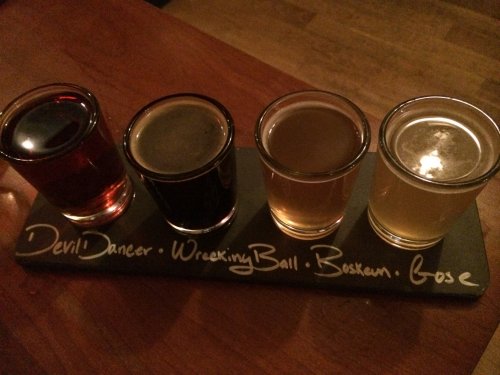
Up first was a South Carolina Gose Gone Wild, the color of lemon juice. And almost as sour. Gose is a beer style that originated in Germany. It was an unusual flavor, reminding me more of grapefruit juice than beer. “Sour is a huge thing right now,” Brendan said of the latest trend in the craft brewing industry. “I’m not a huge fan of sours but always like to taste them and try to understand what people like about them.”
Then came a Belgian De Dolle Boskeun strong ale. Much smoother than the last. “This is a lot easier on the palate than the Gose,” Brendan said. He was right.
Third on the list was the No-Li Wrecking Ball imperial stout from Washington state. “The finish is probably going to resonate a bit,” he cautioned as I sipped. Again, a correct assumption. The first thing I could think of was that the lingering flavor reminded me of the liquor-filled chocolates my Scottish grandmother used to force on us at Christmastime.
Brendan laughed and said the chocolate flavor made sense because the barley used in the higher-alcohol imperial stouts gives off that flavor, as well as the taste of coffee beans. “Part of the aftertaste is also coffee. It reminds me of an espresso,” he said.
Last on the flight was a Founders Devil Dancer Triple Imperial Pale Ale, or IPA, from Michigan. “It’s going to be the strongest one, with a lot of hops,” Brendan warned me. Hops refer to the flowers used to flavor and stabilize beer, with more hops enhancing the flavor. The Devil Dancer had 10 hops. “It’s an extreme example of a very hoppy IPA,” he said.
Extreme was an understatement. I again tasted something like grapefruit as the flowery, strong flavor took over my tongue, finishing off with some residual sugary sweetness. “This just attacks your mouth and doesn’t let go,” Brendan said as we finished our flight.
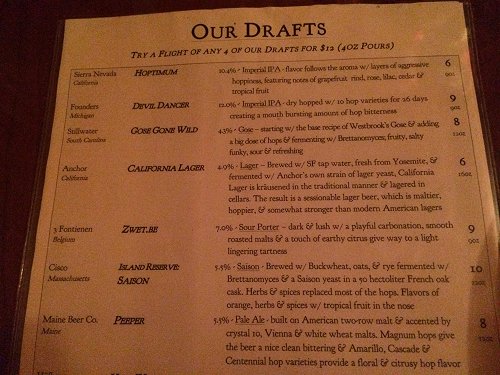
He’s learned a lot about beer from his interviews, and he relishes the chance to get to visit craft breweries and add to that knowledge. He’s done a couple of trade events where he’s met new contacts and has outstanding invites to interview at companies across the country. It’s just a matter of finding the time to make it to places like Florida and California.
Brendan is also applying his acquired knowledge by brewing beer at home: he’s currently preparing his first-ever batch. Ultimately, he’d love to have a small restaurant-brewery hybrid where he could make small batches and work with a chef whose food complements the beverages. But for now Brendan is focusing on his website.
Apparently the government has a definition of craft beer as producing 6 million barrels per year or less, though Brendan thinks that number should probably be closer to 10,000 barrels to qualify as a truly craft, unique beverage. But he said that everyone has their own opinion on what makes a beer a craft one. “Is craft something different every time you taste it? Or different but it maintains the same consistency every time you taste it?” he asked in an open-ended way.
Brendan hinted his preference for smaller-run breweries producing a range of flavors, yet at the same time being consistently great-tasting. That doesn’t mean he faults the craft breweries that are turning out batches of one or two popular beers in lieu of greater experimentation, saying their business model makes sense too.
“Some people believe in breadwinners, and you can never fault someone for wanting to make money,” he said. “Your one-offs aren’t always going to hit.”
By this time, two hours had passed and we were almost the last diners in the restaurant. So Brendan decided that instead of dessert we should have one last quick beer.
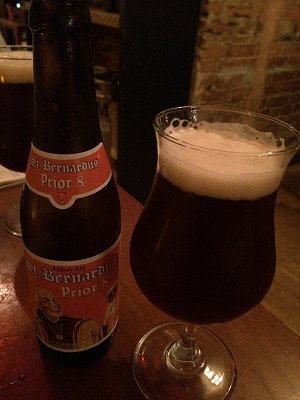
He recommended the St. Bernardus Prior 8 ale from Belgium. The malty beer is best served a little warm, he said, because it allows its flavor to become stronger. “It’ll take over your mouth and throat,” Brendan said. An accurate description, because one gulp of the St. Bernardus and it was all I could taste for a while, hints of a coffee flavor among all that malt.
“That probably cleared everything off your palate,” Brendan said. “It’s sugary, sweet, almost like a dessert. It’s a very good way to cap a meal off.”
Although neither of us was drunk that night, I wondered how Brendan managed to do all these interviews and not get intoxicated. He said he was blessed with genes that mean he doesn’t get hungover — so now me, with a weaker constitution, hates him — and that prior to interviews if he has a banana, yogurt and two liters of sparkling water to prevent the alcohol affecting him.
That allows him to stay sharp when talking about beer. And, as I found out that night, he doesn’t just talk about beer when he has a microphone in front of him. When one of the restaurant staff checked in with us on whether we liked the beer flight, Brendan happily chatted with him.
They shared common points of knowledge about local breweries, and Brendan again came across as someone who takes an every man’s approach to loving something and trying to learn as much about it as possible. I’m a layman on beer, so it was interesting to see Brendan talked with the employee, who also clearly knew what he was talking about.
Brendan was engaging and inquisitive on the topic of craft beer, and it’s that kind of passion for the subject that helps him get behind the craft.
ivywhp
ampji0
pr59xx